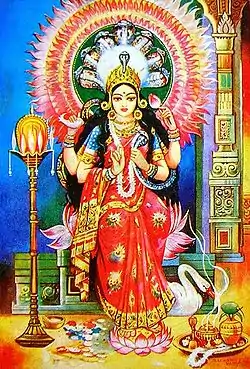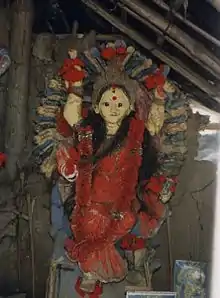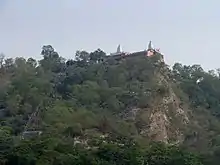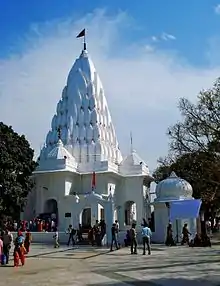Manasa
Manasa, also Manasa Devi, is a goddess of snakes, worshipped mainly in Bengal, Jharkhand and other parts of northeastern India, chiefly for the prevention and cure of snakebite and also for fertility and prosperity. Manasa is the mother of Astika, sister of Vasuki, king of Nāgas (snakes) and wife of sage Jaratkaru.[1] She is also known as Vishahara (the destroyer of poison), Nityā (eternal) and Padmavati.[2]
| Manasa | |
|---|---|
Goddess of snakes | |
 | |
| Devanagari | मनसा |
| Sanskrit transliteration | Manasā |
| Bengali / Hajong | মনসা / কাণি দেউও (Kānī Dīyāʊ) |
| Affiliation | Devi, Nāga |
| Weapon | Snakes |
| Mount | Snake, Swan |
| Personal information | |
| Siblings | Vasuki |
| Consort | Jaratkaru (in Mahabharata) |
| Children | Astika (in Mahabharata) |
Her myths emphasize her bad temper and unhappiness, due to rejection by her father Shiva and her husband, and the hate of her stepmother, Chandi (Shiva's wife, identified with Parvati in this context). In some scriptures, sage Kashyapa is considered to be her father, not Shiva. Denied full godhead by her mixed parentage, Manasa's aim was to fully establish her authority as a goddess and to acquire steadfast human devotees.[3] Manasa is depicted as being kind to her devotees, but harsh to people who refused to worship her.[4]
Origins
As per McDaniel, Manasa was originally an Adivasi (tribal) goddess. She was accepted in the pantheon worshipped by Hindu lower caste groups. Later, she was included in higher caste Hindu pantheon, where she is now regarded as a Hindu goddess rather than a tribal one.[4] Bhattacharya and Sen suggest that Manasa originated in South India as a non-Vedic and non-Aryan goddess and is related to the Kannada folk snake-goddess Manchamma.[5] Dimock suggests that though snake worship is found in the Vedas (the earliest Hindu scriptures), Manasa - a human goddess of snakes - has "little basis" in early Hinduism.[6] Bhattacharya suggests another influence on Manasa being the Mahayana Buddhist goddess of poison-cure Janguli. Janguli shares his swan vehicle and her poison-destroyer epithet with Manasa. Manasa is also known as Jaguli. A theory suggests that Janguli may have influenced by the Kirata-giri ("the conqueror of all posions") of the Atharvaveda.[7]
According to Tate, Manasa as Jaratkaru was initially recognized as a daughter of sage Kashyapa and Kadru, the mother of all Nāgas in the Hindu epic Mahabharata.[8][9] According to Bhattacharya, the Jaratkaru of the Mahabharata is not the Manasa popular in Bengal.[10]
According to Tate: By the 14th century, Manasa was identified as the goddess of fertility and marriage rites and was assimilated into the Shaiva pantheon, related to the god Shiva. Myths glorified her by describing that she saved Shiva after he drank the poison, and venerated her as the "remover of poison". Her popularity grew and spread to southern India, and her followers began to rival Shaivthe earliestism (the cult of Shiva). As a consequence, stories attributing Manasa's birth to Shiva emerged and ultimately Shaivism adopted this indigenous goddess into the Brahmanical tradition of mainstream Hinduism.[9] Alternatively, S B Dasgupta suggests that the Bengali tale of Manasa reflects rivalry between Shaivism and the Goddess-centric Shaktism.[11]
Iconography
Manasa is depicted as a woman covered with snakes, sitting on a lotus or standing upon a snake. She is sheltered by the canopy of the hoods of seven cobras. Sometimes, she is depicted with a child on her lap. The child is assumed to be her son, Astika.[1][12]
Legends
Mahabharata
The Mahabharata tells the story of Manasa's marriage. Sage Jagatkāru practised severe austerities and had decided to abstain from marriage. Once he came across a group of men hanging from a tree upside down. These men were his ancestors, who were doomed to misery as their children had not performed their last rites. So they advised Jagatkāru to marry and have a son who could free them of those miseries by performing the ceremonies. Vasuki offered his sister Manasa's hand to Jagatkāru. Manasa gave birth to a son, Astīka, who freed his ancestors. Astika also helped in saving the Nāga race from destruction when King Janamejaya decided to exterminate them by sacrificing them in his Yajna, fire offering.[13]
Puranas

The Puranas are the first scriptures to speak about her birth. They declare that sage Kashyapa is her father, not Shiva as described in the later Mangalkavyas. Once, when serpents and reptiles had created chaos on the Earth, Kashyapa created the goddess Manasa from his mind (mana). The creator god Brahma made her the presiding deity of snakes and reptiles. Manasa gained control over the earth, by the power of mantras she chanted. Manasa then propitiated the god Shiva, who told her to please the god Krishna. Upon being pleased, Krishna granted her divine Siddhi powers and ritually worshiped her, making her an established goddess.[14]
Kashyapa married Manasa to sage Jaratkaru, who agreed to marry her on the condition that he would leave her if she disobeyed him. Once, when Jaratkaru was awakened by Manasa, he became upset with her because she awakened him too late for worship, and so he left her temporarily. On the request of the great Hindu gods, Jaratkaru returned to Manasa and she gave birth to Astika, their son, before deserting his wife again.[14]
Mangalkavyas

The Mangalkavyas were devotional paeans to local deities such as Manasa, composed in Bengal between the 13th and the 18th centuries. The Manasa Mangalkavya by Vijay Gupta and Manasa Vijaya (1495) by Bipradas Pipilai trace the origin and myths of the goddess. However these stray further from Puranaic references probably due to creative licenses exercised.
At least fifteen Mangalkavyas dedicated to Manasa are known. Scholar D. C. Sen traced fifty-one versions of her tale.[15]
According to Manasa Vijaya, Manasa was born when a statue of girl that had been sculpted by Vasuki's mother was touched by Shiva's seed. Vasuki accepted Manasa as his sister, and granted her charge of the poison that was produced when King Prithu milked the Earth as a cow. When Shiva saw Manasa, he was attracted to her, but she proved to him that he was her father. Shiva took Manasa to his home where his wife, Chandi, suspected Manasa of being Shiva's concubine or co-wife, and insulted Manasa and burnt one of her eyes, leaving Manasa half-blind. Later, when Shiva was dying of poison, Manasa cured him. On one occasion, when Chandi kicked her, Manasa rendered her senseless with a glance of her poison eye. Finally, tired of quarrels between Manasa and Chandi, Shiva deserted Manasa under a tree, but created a companion for her from his tears of remorse, called Neto or Netā.[16]
Later, the sage Jaratkaru married Manasa, but Chandi ruined Manasa's wedding night. Chandi advised Manasa to wear snake ornaments and then threw a frog in the bridal chamber which caused the snakes to run around the chamber. As a consequence, the terrified Jaratkaru ran away from the house. After few days, he returned and Astika, their son, was born.[17]

Accompanied by her adviser, Neto, Manasa descended to earth to see human devotees. She was initially mocked by the people but then Manasa forced them to worship her by raining calamity on those who denied her power. She managed to convert people from different walks of life, including the Muslim ruler Hasan, but failed to convert Chand Sadagar. Manasa wanted to become a goddess like Lakshmi or Saraswati. To get there, she had to achieve the worship of Chand Sadagar who was extremely adamant and took oath not to worship Manasa. Thus to gain his fear and insecurity, Manasa one by one killed his six sons. At last Manasa conspired against two dancers of Indra s Court who loved each other, Anirudha and Usha. Anirudh had to take birth as Lakhinder, Chand and Sanaka's seventh son. Usha took birth as Behula and married him. Manasa killed him but Behula floated on water for nine months with the dead body of her husband and finally brought back the lives of the seven sons and the lost prosperity of Chand. At last, he yielded by offering a flower to the goddess with his left hand without even looking at her. This gesture made Manasa so happy that she resurrected all of Chand's sons and restored his fame and fortunes. The Mangal kavyas say that after this, the worship of Manasa was popular forever.[18]
Manasa Mangalkavya attributes Manasa's difficulty in attracting devotees to an unjust curse she gave to Chand in his previous life. Chand then retaliated with a counter-curse that worshiping her would not be popular on earth unless he worshiped her also.[19]
Ananda K. Coomaraswamy and Sister Nivedita say, "[The] legend of [Chand Sadagar and] Manasā Devī, [...] who must be as old as the Mykenean stratum in Asiatic society, reflects the conflict between the religion of Shiva and that of female local deities in Bengal. Afterwards Manasā or Padmā was recognized as a form of Shakti, [...] and her worship accepted by Shaivas. She is a phase of the mother-divinity who for so many worshipers is nearer and dearer than the far-off and impersonal Shiva...".[20]
Worship
Generally, Manasa is worshiped without an image. A branch of a tree, an earthen pot or an earthen snake image is worshiped as the goddess,[1] though images of Manasa are worshipped too. She is worshiped for protection from and cure of snake bites and infectious diseases like smallpox and chicken pox.
The following of Manasa is most widespread in Bengal, where she is ritually worshiped in temples. The goddess is widely worshiped in the rainy season, when the snakes are most active. Manasa is also a very important fertility deity, especially among the lower castes, and her blessings are invoked during marriage or for childlessness. She is usually worshiped and mentioned along with Neto, who is called Neta, Netidhopani, Netalasundori, etc. in various parts of Bengal.
In North Bengal, among the Rajbanshis, Manasa (called Bishohora, Bishohori or Padmavati) is one of the most important goddesses, and her thaan (shrine) may be found in the courtyard of almost every agrarian household. Among the lower-caste Hindus of East Bengal (present-day Bangladesh)too, she is worshiped with great pomp.
Manasa is an especially important deity in Bengal for the mercantile castes. This is because Chando of the Manasamangal was the first to initiate her worship, and Behula, the heroine of the Manasamangal was a daughter of the Saha clan (a powerful trading community).
Manasa is also worshiped extensively in Assam and Tripura, and a kind of Oja-Pali (musical folk theatre) is dedicated entirely to her myth.
Manasa is ceremonially worshiped on Nag Panchami - a festival of snake worship in the Hindu month of Shravan (July–August). Bengali women observe a fast (vrata) on this day and offer milk at snake holes.[21]
In South India people started recently worshipping Goddess Manasa Devi[22] Temple in Mukkamala located in West Godavari, Andhra Pradesh.
Notable temples


 Mansa Devi Temple, Kandra, Jharkhand
Mansa Devi Temple, Kandra, Jharkhand
- Mansa Devi Temple, Mukkamala[23], West Godavari, Andhra Pradesh
- Mansa Devi Temple, Naidupeta, Nellore , Andhra Pradesh
- Mansa Devi Temple, Tilaru, Srikakulam , Andhra Pradesh
- Mansa Devi Temple, Dornipadu, Kurnool , Andhra Pradesh
- Mansa Devi Temple, Kanumalapalle, kadapa , Andhra Pradesh
- Mansa Devi Temple, Chinadugam, Srikakulam , Andhra Pradesh
- Mansa Devi Temple, Kurnool, Andhra Pradesh
- Mansa Devi Temple, Nellore, Andhra Pradesh
- Mansa Devi Temple, Thurpu Rompidodla, Nellore , Andhra Pradesh
- Mansa Devi Temple, Vadluru, West Godavari , Andhra Pradesh
Notes
- Wilkins p.395
- Dowson, John (2003). Classical Dictionary of Hindu Mythology and Religion, Geography, History. Kessinger Publishing. p. 196. ISBN 0-7661-7589-8.
- Radice, William (2001). Myths and Legends of India. Viking Penguin Books Ltd. pp. 130–8. ISBN 9780670049370.
- McDaniel p.148
- Dimock 1962, pp. 315-6.
- Dimock 1962, pp. 312-3.
- Dimock 1962, p. 316-7.
- Dimock 1962, pp. 313-4.
- Tate, Karen (2005). Sacred Places of Goddess: 108 Destinations. CCC Publishing. p. 194. ISBN 1888729112.
- Dimock 1962, p. 315.
- Dimock 1962, p. 311.
- Chaplin, Dorothea (2007). Mythlogical Bonds Between East and West. READ BOOKS. p. 28. ISBN 9781406739862.
- Wilkins p.396
- Sharma, Mahesh (2005). Tales from the Puranas. Diamond Pocket Books (P) Ltd. pp. 38–40. ISBN 81-288-1040-5.
- Dimock 1962, p. 309.
- McLean p. 66
- McDaniel p. 149-51
- Coomaraswamy, Ananda K.; Sister Nivedita (2003). Myths of the Hindus and Buddhists. Kessinger Publishing. pp. 324–30. ISBN 0-7661-4515-8.
- McDaniel p.152
- Coomaraswamy, Ananda K.; Sister Nivedita (2003). Myths of the Hindus and Buddhists. Kessinger Publishing. p. 330. ISBN 0-7661-4515-8.
- McDaniel (2002) p.55-57
- "Sri Manasa Devi Temple in Mukkamala Peetam". Sri Sri Sri Vasavi Kanyaka parameswari. 24 June 2016. Retrieved 17 November 2017.
- Mukkamala, West Godavari district
References
- McDaniel, June (2004). Offering Flowers, Feeding Skulls: Popular Goddess Worship in West Benegal. Oxford University Press, US. p. 368. ISBN 0-19-516790-2.
- Wilkins, W. J. (2004). Hindu Mythology, Vedic and Puranic (First published: 1882 ed.). Kessinger Publishing. p. 428. ISBN 0-7661-8881-7.
- McDaniel, June (2002). Making Virtuous Daughters and Wives: An Introduction to Women's Brata Rituals in Bengali Folk Religion. SUNY Press. p. 144. ISBN 0-7914-5565-3.
- Dimock, Edward C. (1962). "The Goddess of Snakes in Medieval Bengali Literature". History of Religions. 1 (2): 307–321. doi:10.1086/462451. JSTOR 1062059. S2CID 162313578.
